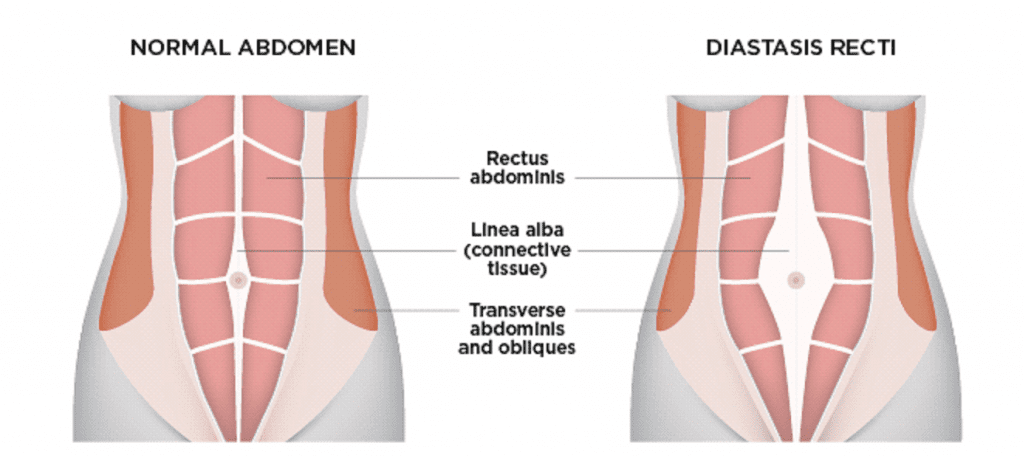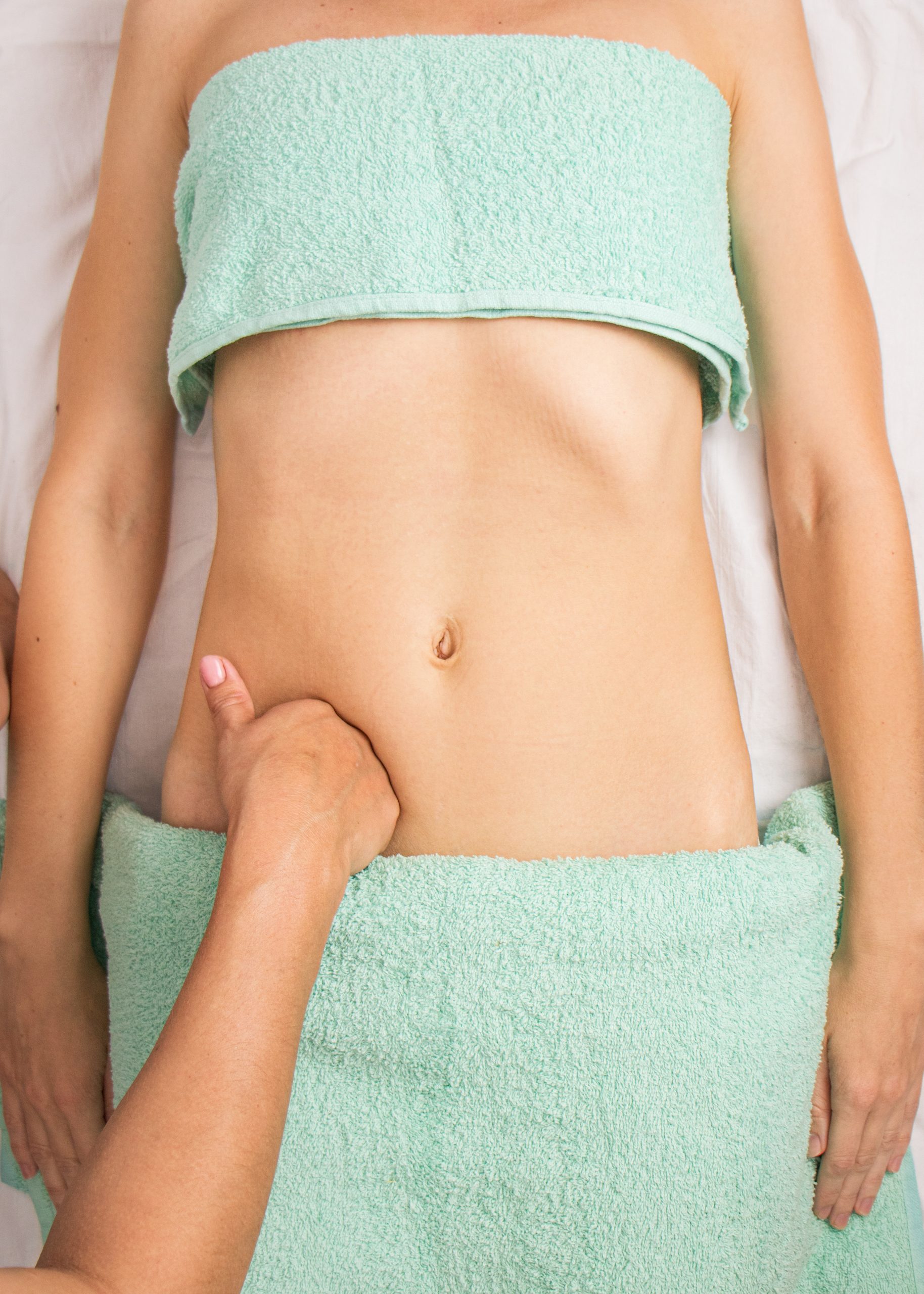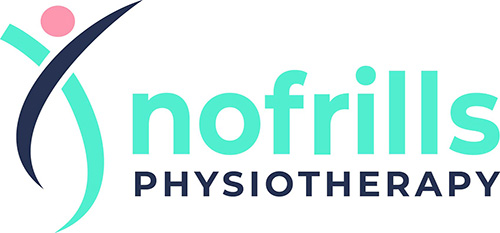Services
Diastasis Recti: What is Mummy Tummy all about?
Childbirth is remarkable but physically taxing, requiring 6 to 8 weeks for recovery. Some mothers may face issues like diastasis recti needing extra attention.
What is Diastasis Recti?
Diastasis Recti is a common postnatal condition characterized by the separation of the left and right halves of the abdominal muscles, known as the rectus abdominis. This separation occurs during pregnancy as the growing fetus exerts pressure on the abdominal wall, stretching the connective tissues that keep the muscles together. After childbirth, these tissues often remain stretched, resulting in a protruding belly and a noticeable bulge.

What causes my abdominal muscles to separate?
Abdominal muscle separation is common during pregnancy, and in many cases, it resolves on its own. However, Diastasis Recti occurs when the separation persists long after childbirth. This condition affects about 30% of new mothers and is more likely in women who have had multiple pregnancies or who have given birth to larger babies or twins. A larger belly exerts more pressure on the connective tissues between the abdominal muscles, stretching them further. As these tissues become increasingly stretched, they weaken, making it more challenging for them to heal properly.
The impact of Diastasis Recti
In most instances, diastasis recti doesn’t pose serious health risks. However, many women may feel self-conscious due to the tummy bulge, which can resemble a pregnant belly, affecting their body image and confidence.
In rare, more severe cases, diastasis recti may lead to issues such as back pain, constipation, and breathing difficulties.
How to tell if I have Diastasis Recti?

Diastasis Recti Treatment Methods: What works for me?
Who would have guessed that the physical challenges of pregnancy don’t just vanish after childbirth? The journey of childbirth is physically demanding, leaving new mothers vulnerable to various postnatal injuries. In our previous article, we explored a common postnatal condition—Diastasis Recti, often referred to as “Mummy Tummy.”
We discussed the condition, its causes, and its impact on new mothers. In this article, we’ll delve into the various treatment options for diastasis recti, helping you understand your choices. We’ll also discuss whether seeking treatment for diastasis recti is necessary.

When should I seek diastasis recti treatment?
The urgency to seek treatment for diastasis recti depends on the severity of the separation. In cases where the separation is significant, prompt medical attention is more critical.
In its mild form, diastasis recti may simply present as a tummy bulge. However, in some instances, it can significantly impact daily life and functionality. If left untreated, it may lead to further complications.
If you’re experiencing any of the following symptoms, your condition may be more serious, and it’s advisable to consult a trained professional:
- Constipation
- Low back pain
- Incontinence (difficulty controlling the bladder, leading to leakage)
- Hernia (when an organ pushes through the gap created by the separated muscles)
If you’re facing any of these issues, please seek medical assistance. It’s advisable to discuss your concerns with your previous gynecologist or a doctor specializing in women’s health to confirm the diagnosis of diastasis recti before beginning treatment. This ensures an accurate diagnosis and that the treatment plan is appropriate for your specific condition.
How severe is my diastasis recti?
Normal Separation
As mentioned earlier, some degree of separation is normal after delivery. If the separation is less than 2 fingers wide, it does not indicate diastasis recti. This level of separation in the abdominal muscles is typical and should heal on its own within 6 to 8 weeks after childbirth.
Mild Diastasis Recti
If the separation is between 2 to 3 fingers wide, you have mild diastasis recti. This is the minimum classification for the condition, as a separation of at least 2 fingers indicates that it is indeed diastasis recti.
Signs of this condition include:
– Difficulty straightening your knee
– A sensation of your knee feeling “locked”
– Swelling and stiffness in the knee
Moderate
If the separation is 3 to 4 fingers width apart, you have moderate diastasis recti.
Severe Diastasis Recti
If the separation measures 4 fingers wide or more, it’s crucial to seek medical treatment. This level of separation is considered severe and may lead to complications such as a hernia or damage to pelvic floor functions, potentially affecting your daily activities and overall quality of life.
Our available treatments for Diastasis Recti
Tummy Binding
Postpartum wrapping, also known as tummy binding, is a common practice during recovery after childbirth. It aims to enhance core strength and help prevent diastasis recti. You can start using it as early as five days post-delivery, but it’s important to wear it only for short periods to avoid dependency. While it offers support, excessive binding can increase abdominal pressure and may lead to pelvic floor issues. It’s advisable to consult a doctor before starting this practice.
Core Strengthening Exercises
The goal of these exercises is to strengthen the deep core muscles, including the transverse abdominis and pelvic floor muscles. However, poorly executed or inappropriate core strengthening exercises can lead to increased intra-abdominal pressure, which may exacerbate abdominal separation and worsen your condition. It’s essential to perform core exercises specifically designed for diastasis recti treatment to ensure safe and effective results.
Real-time ultrasound imaging
Your physiotherapist can utilize ultrasound imaging as a valuable tool in assessing abdominal muscles during your recovery. Real-time ultrasound imaging is considered the gold standard among physiotherapists for teaching and training the deep muscles of the trunk and lower back. This technique involves using a diagnostic ultrasound machine placed over the deep muscles while you contract a specific muscle.
Benefits of Real-Time Ultrasound Imaging
- Visual Feedback: Clients can see the activation or inactivation of muscles, enhancing understanding.
- Immediate Feedback: This accelerates learning and helps refine technique.
- Objective Progress Measurement: Clients can track their improvement over time.
- Increased Motivation and Compliance: Visual progress can boost commitment to the treatment plan.
- Functional Assessment: We can evaluate muscle stability in positions relevant to daily activities (e.g., assessing stability when getting up from a seated position).
Diastasis Recti Surgery
In severe cases where other treatment methods are ineffective, surgery may be necessary. If your diastasis recti is impacting your daily activities or quality of life, you might consider surgical options. Diastasis recti surgery aims to bring the separated abdominal muscles back together and is similar to a tummy tuck procedure.
It’s important to consult your doctor to explore the various treatment methods available and determine which option is best suited for your individual needs.
Office
279 Tanjong Katong Road
Singapore 437062
Monday to Friday : 9am – 8pm
Saturday : 10am – 7pm
Sunday : 10am – 6pm
Services
Knee Pain
Shoulder Pain
Neck Pain
Elbow and Wrist Pain
Ankle and Foot Pain
Stretch Therapy
Sports Therapy
Women's Health
Contact
(+65) 9007 1085
hello@nofrillsphysiotherapy.com
Address: 279 Tanjong Katong Road
Singapore 437062
Other Physiotherapy Services
Shockwave Therapy
Dry Needling
Sports Massage
Functional Fitness
Workplace Health
